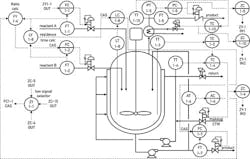By Greg McMillan
There is a confluence of capability and profitability for advanced control. Valves with smart digital positioners and new sensor technologies with smart transmitters have a resolution and threshold sensitivity better than 0.1%. Smart analyzers are more reliable and maintainable. An enhanced PID can deal inherently with analysis sample, cycle and multiplex time delays. A whole host of PID features available today can make optimization easier and faster to implement. At the same time, energy costs have more than doubled.
Simplifying Optimization
The full capability of the PID is not used. The May-August 2011 series of "Control Talk" columns (May, p. 64; June, p. 63; July, p. 47; August, p. 63) on extraordinary PID innovations highlighted some of the many possibilities for using more of the power of the PID. The PID is capable of achieving a safe, clean, efficient, profitable and compliant production unit—the key characteristics of a sustainable plant.
By using ever-expanding features of the PID, advanced control can be implemented with a simple configuration change. PID valve position controllers (VPC) and override controllers can be added to optimize existing loops without the need for new measurements or valves. Options are simply turned on to help the PID fulfill new roles. Additional software, tools and graphics are not needed. PID faceplate controllers are just added to existing displays. Training is minimal and can focus on functionality, since the operators are comfortable and proficient with the standard PID faceplate interface.
Minimizing Energy Use
Wherever there is an adjustable utility source, there is an opportunity to use a VPC to increase its efficiency. The largest of the valve positions of the process loops that are users of the utility is selected as the process variable (PV) for the VPC. The setpoint is a maximum desirable throttle (optimum) position of the process PID valve, which is a constraint to less energy use. The output of the VPC cascades to the setpoint of a utility PID.
The most frequent configuration involves selecting the furthest open valve of process loops, setting the utility flow to a unit operation. The VPC maximizes the valve positions of process loops, throttling utility flows to minimize the pressure from boilers, compressors and pumps; maximizing the temperature from cooling towers and chillers; and minimizing the temperature from heaters.
To reduce compressor energy, use the widest open valve of gas feed loops for a parallel train of reactors as the PV for a VPC whose output adjusts the pressure setpoint of the compressor, resulting in a more optimum speed. The VPC lowers the compressor pressure setpoint until the one of the feed valves reaches the maximum throttle position. For liquid feeds, the VPC lowers pump speed to reduce energy use. For a boiler, the VPC lowers the boiler pressure setpoint to force the furthest open steam control valves in a parallel train of columns or vessels to a maximum throttle position.
The control valve could be the output of a steam flow controller providing boil-up via a reboiler or a reactor temperature controller providing heat-up via a jacket. For a chiller or cooling tower, the VPC raises the supply temperature to force the furthest open the valve of a user loop to a maximum throttle position. For heaters, the VPC lowers the supply temperature.
For improving the efficiency of nearly identical parallel trains and loops, use a high signal selector to choose the furthest open valve as the input to a single VPC. While there is no such thing as identical equipment, the dynamics can be similar enough regardless of which valve is selected to enable the use of a single VPC. If the unit operations or process loops are quite different, a VPC is dedicated to each process loop valve. A low and high signal selector of VPC outputs is used to lower supply pressure and raise supply temperature, respectively.
When the situation involves utilities with different costs, a VPC can maximize the use of the least expensive utility, such as gas or liquid wastes. The VPC increases the waste fuel setpoint until the purchased fuel (e.g., natural gas or fuel oil) valve reaches a minimum throttle position. A low conventional fuel setpoint limit ensures flame stability for boilers.
Maximizing Production
To maximize the production rate of a unit operation, use a VPC to monitor each valve throttled by process PID to increase the feed rate. Since the process loops are quite different, a VPC is dedicated to each, and the lowest output of the override VPC is used to set feed rate.
To maximize the production rate of a reactor with process loops for pressure control and jacket and condenser temperature, use the lowest output of a VPC to prevent the vent valve or cooling water valve to the condenser or jacket from opening too far. To prevent carry-over into the vent system, add an override PID that uses radar to measure foam level. Alternatively, the VPC controllers can be used to raise the reactor temperature setpoint to a permissible limit, increasing an exothermic reaction rate until a VPC says enough is enough. The high limit prevents undesirable reactions or excessive heat release.
For a column, the feed setpoint is the lowest output of the individual VPC responsible for preventing flow, level, temperature and pressure control loops from running out of valve, that is, having it go too far open and losing sensitivity from the installed valve characteristic being too flat at the upper end of the valve stroke.
Additional override controllers may be added to the mix to prevent flooding by keeping the differential pressure from getting too high across a key section of the column. Alternatively, use the VPC controllers to lower column temperature setpoint to a permissible limit, increasing distillation rate.
Minimizing Reagents
A VPC can maximize waste reagent use by forcing the purchased reagent manipulated by the pH PID to a minimum throttle position. For several stages of neutralization, a VPC can minimize the pH setpoint of the first stage for acidic waste until the final stage pH base trim valve reaches a maximum throttle position. For basic waste, the VPC would maximize the first stage setpoint. A VPC process variable can be computed to prevent cross-neutralization of reagents from multiple-stage, split-ranged operation.
Minimizing Reactants
Composition controllers can maximize yield by adjusting the ratio of reactants to be closer to the stoichiometric ratio. The at-line analyzer PID provides a bias correction to the ratio of reactants to account for bias errors in the flow measurements. A VPC can adjust the input bias to the flow feed-forward to move the analyzer PID output to 50%, which is the point of zero feedback correction of the reactant flow measurement.
Maximizing Flexibility
Plant-wide, feed-forward control can move flows in unison per ratios established by the process flow diagram (PFD). Flow feed-forward enables the process controllers to stay close to setpoint for changes in production rate or product grade. The result is fast and smooth changes in flows with minimal disruption to process variables. The production rates and grades can be optimized based on market demand, day-to-night utility rates, and waste fuel and reagent supply. The flexibility translates to minimum inventory and maximum efficiency. Feed-forward summers are generally used because of their robustness and simplicity. When the process controller output is 50%, there is no bias correction to the feed-forward. A VPC can correct the flow input bias or ratio factor or feed-forward gain to return the process controller output to 50%.
Key PID Features
Several features of the PID increase the functionality of the VPC and make the tuning easier and more robust. Directional velocity limits on setpoints manipulated by the VPC combined with dynamic reset limits in the VPC PID enable faster correction by the VPC when a process PID valve is going open to prevent running out of valve. When the process PID valve is decreased to a less efficient setting, a more gradual approach can be used. The result is a cautious approach to optimization with a fast getaway to prevent violating a constraint. The controller can be tuned for fastest correction. The dynamic reset limits in the VPC PID prevent the VPC output from changing faster than the process PID can respond, greatly simplifying the tuning.
The tuning of the VPC can be automatically identified and scheduled by an adaptive tuner. It increases VPC control action by a higher VPC gain for a higher PV corresponding to the process PID valve moving to a flatter portion of the installed characteristic. This works in conjunction with the directional velocity limits to prevent excessively exceeding a valve position constraint. Feed-forward of unmeasured disturbances can be used to assist the VPC.
An enhanced PID developed for wireless doesn’t change its output unless there is an update in the setpoint, feed-forward or measurement that exceeds a threshold sensitivity limit. By suspending integral action until there is an update, limit cycles from valve stiction and backlash are eliminated. The interaction between the process PID and VPC PID is also suppressed by setting the threshold sensitivity limit to ignore inconsequential changes in the process PID output. If a VPC execution time is chosen that exceeds the process response time, the VPC gain can be set equal to the inverse of the product of the process gains, enabling a single correction for a deviation in optimum valve position.
The enhanced PID can also suppress oscillations from the sample time, cycle time and multiplex time of at-line analyzers. By waiting for an update in the communicated analysis, the enhanced PID does not cycle due to an excessive update delay. If the total delay in the analysis result is much greater than the process response time, the enhanced PID gain can be set equal to the inverse of the process gain, enabling a single correction for setpoint and composition changes. The elimination of cycling and the simplification of tuning make the job of the VPC optimizing the at-line analyzer PID valve much easier.
Greg McMillan is a retired Senior Fellow from Solutia/Monsanto, an ISA Fellow, and a member of the Process Automation Hall of Fame.






